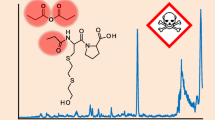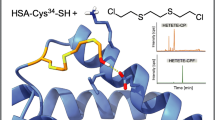Abstract
We present the forensic analyses of plasma samples of human victims exposed to sulfur mustard (SM) in a crisis region in the Middle East in 2015. A few hours after exposure, poisoned persons showed typical signs and symptoms of percutaneous SM exposure including erythema and later on blisters and hardly healing skin wounds. Blood samples were collected 15 days after poisoning to be analyzed for the presence of long-lived protein-adduct biomarkers to verify SM poisoning. We applied a novel bioanalytical toolbox targeting four human serum albumin-derived biomarkers that were made accessible after plasma proteolysis. These adducts contained the SM-specific hydroxyethylthioethyl moiety either bound to the thiol group of a cysteine residue (C34*) or to the side-chain carboxylic group of a glutamic acid residue (E230*). Peptide biomarkers were produced from plasma of the victims using proteinase K (C34*PF), pronase (C34*P) and pepsin (AE230*VSKL and LQQC34*PFEDHVKL) for enzymatic protein cleavage. Separation and detection were carried out by selective micro-liquid chromatography–electrospray ionization high-resolution tandem mass spectrometry (µLC–ESI MS/HR MS). In addition to this site-specific adduct detection, a general approach after alkaline hydrolysis of the plasma protein fraction was applied. Liberated thiodiglycol (TDG) was derivatized with heptafluorobutyric anhydride and detected by gas chromatography–electron ionization mass spectrometry (GC–EI MS). The different bioanalytical methods yielded congruent results confirming SM poisoning for all patients who showed clinical signs and symptoms. This is the first time that real cases of SM poisoning were confirmed and presented by such a broad compilation of protein-derived biomarkers.




Similar content being viewed by others
Abbreviations
- ACN:
-
Acetonitrile
- CWA:
-
Chemical warfare agents
- CWC:
-
Chemical weapons convention
- d3-Atr:
-
Triple deuterated atropine
- FA:
-
Formic acid
- GC–EI MS:
-
Gas chromatography–electron ionization mass spectrometry
- HSA:
-
Human serum albumin
- HETE:
-
Hydroxyethylthioethyl
- HFBA:
-
Heptafluorobutyric anhydride
- iPrOH:
-
Iso-propanol
- TDP:
-
Thiodipropanol
- µLC–ESI MS/HRMS:
-
Micro-liquid chromatography–electrospray ionization high-resolution tandem mass spectrometry
- SIM:
-
Selected ion monitoring
- SM:
-
Sulfur mustard
- SPE:
-
Solid-phase extraction
- TDG:
-
Thiodiglycol
- TOF:
-
Time-of-flight
- UF:
-
Ultrafiltration
References
Andacht TM, Pantazides BG, Crow BS et al (2014) An enhanced throughput method for quantification of sulfur mustard adducts to human serum albumin via isotope dilution tandem mass spectrometry. J Anal Toxicol 38:8–15
Barr JR, Pierce CL, Smith JR, Capacio BR, Woolfitt AR, Solano MI, Wooten JV, Lemire SW, Thomas JD, Ash DH, Ashley DL (2008) Analysis of urinary metabolites od sulfur mustard in two individuals after accidental exposure. J Anal Toxicol 32:10–16
Black RM, Clarke RJ, Harrison JM, Read RW (1997) Biological fate of sulphur mustard: identification of valine and histidine adducts in haemoglobin from casualties of sulphur mustard poisoning. Xenobiotica 27:499–512
Capacio BR, Smith JR, Lawrence RJ, Boyd BL, Witriol AM, Conti MT, Collins JL, Sciuto AM (2008) Gas chromatographic-mass spectrometric analysis of sulfur mustard-plasma protein adducts: validation and use in a rat inhalation model. J Anal Toxicol 32:37–43
Carol-Visser J, van der Schans M, Fidder A et al (2008) Development of an automated on-line pepsin digestion–liquid chromatography–tandem mass spectrometry configuration for the rapid analysis of protein adducts of chemical warfare agents. J Chromatogr B 870:91–97
Fidder A, Noort D, de Jong AL, Trap HC, de Jong LP, Benschop HP (1996) Monitoring of in vitro and in vivo exposure to sulfur mustard by GC/MS determination of the N-terminal valine adduct in hemoglobin after a modified Edman degradation. Chem Res Toxicol 4:788–792
Gandor F, Gawlik M, Thiermann H, John H (2015) Evidence of sulfur mustard exposure in human plasma by LC–ESI–MS-MS detection of the albumin-derived alkylated HETE–CP dipeptide and chromatographic investigation of its cis/trans isomerism. J Anal Toxicol 39:270–279
John H, Balszuweit F, Kehe K, Worek F, Thiermann H (2015) Toxicokinetic aspects of nerve agents and vesicants. In: Gupta R (ed) Handbook of toxicology of chemical warfare agents, 2nd edn. Academic Press/Elsevier, Amsterdam, pp 817–856
John H, Siegert M, Gandor F et al (2016a) Optimized verification method for detection of an albumin-sulfur mustard adduct at Cys34 using a hybrid quadrupole time-of-flight tandem mass spectrometer after direct plasma proteolysis. Toxicol Lett 244:103–111
John H, Willoh S, Hörmann P, Siegert M, Vondran A, Thiermann H (2016b) Procedures for analysis of dried plasma using microsampling devices to detect sulfur mustard-albumin adducts for verification of poisoning. Anal Chem 88:8787–8794
John H, van der Schans MJ, Koller M, Spruit HET, Worek F, Thiermann H, Noort D (2018) Fatal sarin poisoning in Syria 2013: forensic verification within an international laboratory network. Forensic Toxicol 36:61–71
Kilic E, Ortatatli M, Sezigen S, Eyison RK, Kenar L (2018) Acute intensive care unit management of mustard gas victims: the Turkish experience. Cutan Ocul Toxicol 37:332–337
Lawrence RJ, Smith R, Boyd BL, Capacio BR (2008) Improvements in the methodology of monitoring sulfur mustard exposure by gas chromatography-mass spectrometry analysis of cleaved and derivatized blood protein adducts. J Anal Toxicol 32:31–36
Noort D, Hulst A, de Jong L, Benschop H (1999) Alkylation of human serum albumin by sulfur mustard in vitro and in vivo: mass spectrometric analysis of a cysteine adduct as a sensitive biomarker of exposure. Chem Res Toxicol 12:715–721
Noort D, Fidder A, Degenhardt-Langelaan CEAM, Hulst AG (2008) Retrospective detection of sulfur mustard exposure by mass spectrometric analysis of adducts to albumin and hemoglobin: An in vivo study. J Anal Toxicol 32:25–30
OPCW (2015). https://www.opcw.org/sites/default/files/documents/2018/11/s-1320-2015_e_.pdf. Accessed May 2019
OPCW (2017a) OPCW fact-finding mission confirms use of chemical weapons in Khan Shaykhun on 4 April 2017. https://www.opcw.org/media-centre/news/2017/06/opcw-fact-finding-mission-confirms-use-chemical-weapons-khan-shaykhun-4. Accessed 15 Dec 2018
OPCW (2017b) Statement by H.E. Ambassador Kenneth D. ward permanent representative of the United States of America to the OPCW at the eighty-sixth session of the executive council, https://www.opcw.org/sites/default/files/documents/EC/86/en/ec86nat06_e_.pdf. Accessed 15 Dec 2018
OPCW (2018a) In response to persistent allegations of chemical weapon attacks in Syria, the OPCW Fact Finding Mission (FFM) was set up in 2014 “to establish facts surrounding allegations of the use of toxic chemicals, reportedly chlorine, for hostile purposes in the Syrian Arab Republic”. https://www.opcw.org/fact-finding-mission. Accessed 15 Dec 2018
OPCW (2018b) OPCW issues report on technical assistance requested by the United Kingdom, April 12, 2018. https://www.opcw.org/media-centre/news/2018/04/opcw-issues-report-technical-assistance-requested-united-kingdom. Accessed 15 Dec 2018
OPCW (2018c) Work instruction for the reporting of the results of the OPCW biomedical proficiency tests, quality management system document no. QDOC/LAB/WI/BioPT04. Accessed 4 Jan 2018
Pantazides B, Crow B, Garton J et al (2015) Simplified method for quantifying sulfur mustard adducts to blood proteins by ultrahigh pressure liquid chromatography–isotope dilution tandem mass spectrometry. Chem Res Toxicol 28:256–261
Sezigen S, Ivelik K, Ortatatli M, Almacioglu M, Demirkasimoglu M, Eyison RK, Kunak ZI, Kenar L (2019) Victims of chemical terrorism, a family of four who were exposed to sulfur mustard. Toxicol Lett 303:9–15
Steinritz D, Striepling E, Rudolf K et al (2016) Medical documentation, bioanalytical evidence of an accidental human exposure to sulfur mustard and general therapy recommendations. Toxicol Lett 244:112–120
Vale A, Marrs TC, Maynard RL (2018) Novichok: a murderous nerve agent attack in the UK. Clin Toxicol 56:1093–1097
Xu H, Nie Z, Zhang Y et al (2014) Four sulfur mustard exposure cases: overall analysis of four types of biomarkers in clinical samples provides positive implication for early diagnosis and treatment monitoring. Toxicol Rep 1:533–543
Acknowledgements
We thank Erwin Wagner (InstPharmToxBw) for his excellent technical assistance.
Author information
Authors and Affiliations
Corresponding author
Ethics declarations
Conflict of interest
The authors declare that they have no conflict of interest.
Informed consent
Medically examined patients consented to subsequent blood sample analysis and publication of photographic pictures.
Additional information
Publisher's Note
Springer Nature remains neutral with regard to jurisdictional claims in published maps and institutional affiliations.
Rights and permissions
About this article
Cite this article
John, H., Koller, M., Worek, F. et al. Forensic evidence of sulfur mustard exposure in real cases of human poisoning by detection of diverse albumin-derived protein adducts. Arch Toxicol 93, 1881–1891 (2019). https://doi.org/10.1007/s00204-019-02461-2
Received:
Accepted:
Published:
Issue Date:
DOI: https://doi.org/10.1007/s00204-019-02461-2




